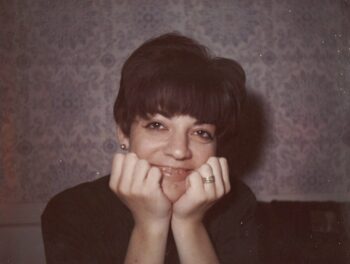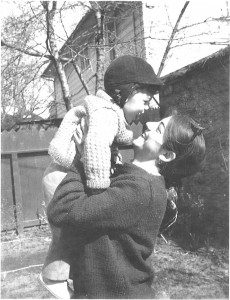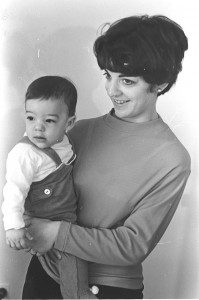
When I was a kid, I would sneak away to look at a picture of Jackie.
I only knew of one: buried behind cabinet doors in the dark wooden bookshelf that took up an entire wall in my parents’ bedroom. I’d slip up the plush, blue-carpeted stairs and kneel down on the dense brown shag of their room. I loved to look through that cabinet, which held all sorts of artifacts from the family’s life before I arrived: my brothers’ elementary school drawings, my father’s high school yearbook, some baby photos of the boys.
Amidst all that was a headshot of Jackie: eight-by-eleven, black and white, with a thick white border on all sides. Her hair is black and falls in soft feathers along her face. Her eyes are deep and dark and capped by thick eyelashes and prominent brows, like my oldest brother Michael. She’s smiling, but I always saw her expression as more intimidating than I’m sure the image actually was. I’d hold the photo as carefully as I could: as the only picture of her that I knew about, it seemed precious. I imbued it with inestimable value: in order for me to live, I knew, Jackie had to die. Besides, I didn’t want anyone to know I’d looked.
*
My father met Jackie in homeroom, their senior year at James Madison High School in the Midwood section of Brooklyn. He was tall and gangly, with black hair and a long face, a charismatic member of Student Government; she was petite and bubbly with a warm smile, voted Best Dressed in their senior yearbook. They were friends first, part of the same tight-knit group, and paired off after college, once the rest of their peers had, too. Two weeks before my father’s twenty-second birthday, they got married in Jackie’s living room.
Michael, my oldest brother, was almost named “4F” because the day my father received his draft board notice in 1966 was the same day Jackie found out she was pregnant. They were living in a small apartment on Bedford Avenue at the time—Jackie supporting the family as a secretary while my father trudged through his first year of law school—and when Robbie was born three years later they set up a crib in the kitchen. They needed more space.
Jackie’s mother, Paulie, suggested they move into the downstairs apartment of the house on Avenue L, the same house where Jackie and her brother grew up. My father hesitated: he and Paulie had never gotten along particularly well, but the pros—built in babysitting, low rent—outweighed those concerns. Besides, Paulie was a working artist who kept to herself; Jackie’s father owned a candy store on Avenue U and hardly ever came home.
They moved into the house in 1970. In 1973, Jon—the youngest of my brothers— was born. On Tuesday, January 22, 1977, when Jon was three and Robbie was six and Michael was nine, Jackie and my father sat together on the couch in the living room and watched Jimmy Carter’s inauguration parade. They were between doctor’s appointments. In the morning they’d gone to see their family practitioner for pain in Jackie’s lower back; by afternoon, they’d learned she had cancer.
It turned out to be Hodgkins Disease, Stage Four. The doctors told my father she had two years to live, and they were right.
*
My father met my mother—a twenty-five year old schoolteacher from Manhattan—on a blind date less than twelve months after Jackie’s death.
When they got engaged, my mother moved into the house. It was “part of the package,” she told me recently; low on her list of concerns about becoming a part of this wounded family. Paulie still lived upstairs, but she was supportive; she wanted the boys to have a mother. She lent my mother her car and picked the boys up from school and didn’t invade their privacy.
My parents waited three years before they had me: their only biological child. My room was the same bedroom that was Jackie’s when she was young. I played in the living room where she and my father had gotten married and the bedroom where she grew ill. Her legacy loomed large, but silent, over my youth: no photos around the house, no conversations about her life or the terrible duration of her illness. My interest in Jackie made me ashamed: she wasn’t my mother to remember or know. If no one else was talking about her, then why should I?
*
Recently, I moved back in with my parents for a brief period after graduate school. I’d been living away for ten years, and the distance had allowed me—finally—to pursue my interest in Jackie. The peculiar parallel of our lives began to consume me: that we shared a family. A home. A room. And yet, could never meet.
I’d started asking my father and others about her, piecing together some details. I learned that she kept a lot of plants. That  she loved daisies and James Taylor. That she was chatty and stylish and talked constantly on the phone. But nothing quite satisfied my longing. Perhaps because I wasn’t sure what that longing was. What had I been searching that photo to find? Was it some connection to Jackie? Or to my brothers, separated from me by ten-plus years and by a tremendous loss I could never, no matter how hard I tried, be able to grasp?
she loved daisies and James Taylor. That she was chatty and stylish and talked constantly on the phone. But nothing quite satisfied my longing. Perhaps because I wasn’t sure what that longing was. What had I been searching that photo to find? Was it some connection to Jackie? Or to my brothers, separated from me by ten-plus years and by a tremendous loss I could never, no matter how hard I tried, be able to grasp?
*
Midwood is far out in Brooklyn on the Q train, toward Coney Island, and has a suburban feel—with separated houses and square, grassy front yards. When my father and Jackie grew up there it was the typical New York mix of middle-class immigrants, Jews and Italians, a few Irish. But in my lifetime it’s become saturated with an insular community of Orthodox Jews. (Both my parents are Jewish, but secular; to the Orthodox, we’re the worst: born “chosen” but living like the rest.) I never had much connection to the neighborhood, attending school in Manhattan as a girl, and, since college, living outside New York. The disconnection I felt from the community, the feeling of being an outsider, an intruder who didn’t belong, mirrored the same feeling I had within my family.
One day I took my dog, a small lab-pit mix I adopted in New Mexico, for a short walk. We went south, toward the elementary school that my brothers attended during the 1970s, PS 193—just three blocks from the house. When Jon, the youngest, was there they christened it the Gil Hodges School. Jackie, I’d recently learned, was head of the PTA.
Walking past, I tried to picture her there: standing inside the tall woven-metal fence, her shoulder-length black hair covered by the bandanas I’ve seen her wearing in some photos; chatting with the other young mothers, the tip of her sunglasses brushing against the thick of her lower lip. I imagined Jon—three when she got sick, five when she died—running outside the red doors to the brick school building to greet her, a red backpack swinging behind him as he wraps his arms around her legs.
I only have a couple of my own memories from that schoolyard; instead of 193, I went to the small, private elementary school in Greenwich Village where my mother taught. But that yard is where my parents taught me to ride a bike; it’s where I once went to play Frisbee with all three of my brothers, and, in a desperate effort to match their distance, hurled my small body onto the asphalt before running home, shaken and bloodied and reminded, again, of the gap between them and me.
But I remember the place enough to recognize how much it’s changed, even since then: there’s a playground now where there wasn’t before; there’s a track marked with bright colored chalk; “courts” for three varieties of hopscotch. It looks different than it did twenty years ago. Surely, even more different than it did when Jackie was alive.
Bonita and I slowed down as we walked past the entrance. Inside the yard, I saw a Russian mother showing her toddler to keep his steps in the drawn boxes; a group of seven year olds playing hockey on skates. We kept going on Bedford towards Avenue K, along the quiet residential streets. It was late morning, the most prominent sounds coming from pipe-shaped leaf-blowers and passing SUVs. But on our way back I circled around, back to Bedford. This time, we went inside: through the opening in the wire fence. Bonita sniffed the asphalt as we walked along the perimeter. We entered into a closed-off area—one I didn’t remember being there before—with a brightly colored jungle gym. Black jigsaws of foam coated the ground, gathering heat.
I noticed a middle-aged man wearing a baseball cap, moving garbage, and felt, suddenly, self-conscious. What must he think I was doing, trolling a school playground, childless, in the middle of the day? As often happens, my concern for a stranger’s perception shifted internal: What was I doing? What was I looking for, wandering around that space? What did I hope to find?
Something, I knew, that would evoke Jackie: some marker of her, some indication, some validation, that this was indeed a place where she spent time; some physical representation of her legacy. I was looking, I suppose, for the same thing I looked for in that photograph.
*
After my mother moved into the house my parents began making changes immediately. They built a second stairwell and took over two of the upstairs rooms, turning the two-family structure into one. There were numerous photos of Jackie around when she moved in, my mother recalls; it made her uncomfortable, but she knew it was up to my father to take them down. Before long, he did.
When I moved home as an adult I slept in the room at the back of the first floor: the one where I slept until I was five, before Robbie, the middle of my brothers, went off to Vassar and I took his old bedroom upstairs. It’s also the one that was Jackie’s, some forty years earlier. Now, my parents refer to it as the “girls room” because it’s where my nieces sleep when they stay over. The bed is now a trundle bed, a narrow twin with a second mattress underneath that pulls out. There’s a blue floral mattress, walls still painted a pale yellow shade. A tall wooden bookshelf holds my mother’s collection of education-related books (Crisis in the Classroom; What to Do On Monday) along with a few shelves of kids’ hardcovers, Shel Silverstein and Chris Van Hollen. A few construction sheets marked with bright crayon drawings are taped to the walls. Taped to the outside of a door is a piece of yellow construction paper scrawled with the words “Grace and Nora’s Spa”—left over from the most recent Thanksgiving. But the framed prints on the wall are my mother’s, too: an article from LIFE magazine featuring her as a second grader struggling with math; an image from Eloise, one of her favorite books.
It’s one of the many ways that my mother has spent the last thirty years making the house hers. The stairs were the first, biggest, thing, she says. More recently she and my father have renovated the kitchen and both bathrooms. They’ve replaced furniture, painted rooms. It was significant not only for my mother, but for my father, too—eager, after two years of caring for an ailing wife, to move on. Certain things still trigger his memories of Jackie—a wool sweater that my mother sometimes wears, the sight of my brother Michael’s fingers and toes, which oddly bulb out the way Jackie’s did, too. No matter how different the house looks now, he could choose to remember her there, too—everywhere, every day. But in order to move on he’s chosen—has had to choose—not to.
*
A couple of years ago I visited Jane Austen’s house in Chawton, England. As you’d expect, it’s a quaint, miniature-sized home, with lovely and well-maintained gardens. It was pleasant and interesting to explore the rooms where Austen may have spent her days, the small-sized wooden desk where she apparently wrote. But there was also something that felt a bit peculiar about it. (Not least, the “Mr. Darcy” mugs and fridge magnets with Colin Firth’s photo on display in the giftshop.) It all felt a bit forced: as though it was really just a museum, and the information could have been presented anywhere. There was something slightly hollow, slightly arbitrary, in remembering her in this particular space.
“We think we no longer love our dead, but that is because we do not remember them: suddenly we catch sight of an old glove and burst into tears.”
Marcel Proust wrote that in a letter to his wife in 1913. I read it a few days ago, in a book by a friend of mine whose child is dying. She is preparing, cruelly, to mourn him, living with a daily grief whose pain I can’t imagine.
 But the quote reminds me of the ways in which we understand something about how to grieve the dead who we know. But what about the dead who we never did?
But the quote reminds me of the ways in which we understand something about how to grieve the dead who we know. But what about the dead who we never did?
We mark significant spaces for them. We build memorials. We engage in grand uses of space. We make places to go, create occasion to support collective memory. We visit the houses where famous people once lived because, in some abstract way, it’s all we can do: you can’t exchange letters with Jane Austen, or visit her at a book signing. To occupy a place that was hers is to grasp for some concrete connection with someone who’s gone, and whose life you missed.
There are no triggers of memory for the dead we didn’t know. We have to make them ourselves.
*
As I walked home that morning, past the synagogue and shingled houses along Avenue L, it was plain that nothing about that schoolyard—that place where Jackie spent so many mornings and early afternoons—evoked her. Just, I thought, as there is nothing of her left in what was our mutual childhood bedroom. It would be easy to move through these spaces without thinking of her, nothing intrinsic that would bring my thoughts to Jackie.
For my father and brothers, to imbue the spaces where Jackie lived with her memory is a painful act, loaded with years of trauma, a lifetime of grief. Their associations are real—not invented, like mine. For them, to see her memory in every schoolyard or room or sweater is tinged with sadness and loss. But I never knew Jackie. And in some strange, ironic way, my distance, the fact that I don’t have actual memories of her, makes it easier for me to find her in these shared spaces—even when there’s nothing to really see.




